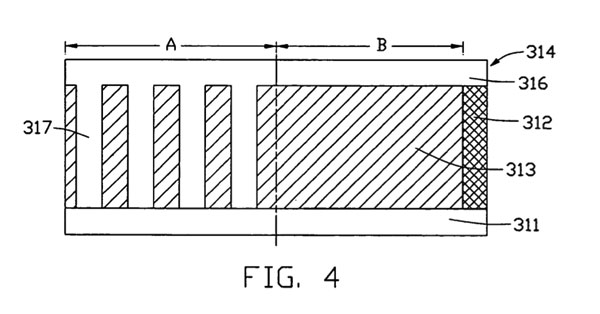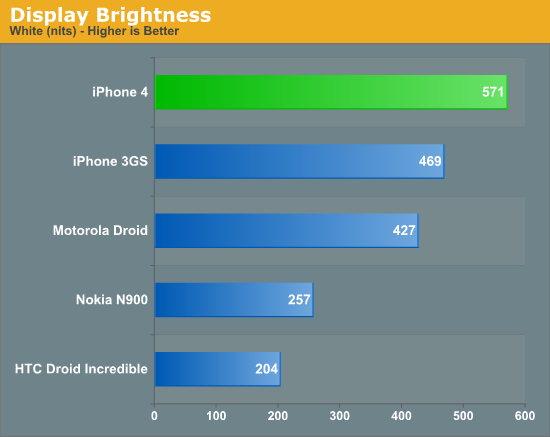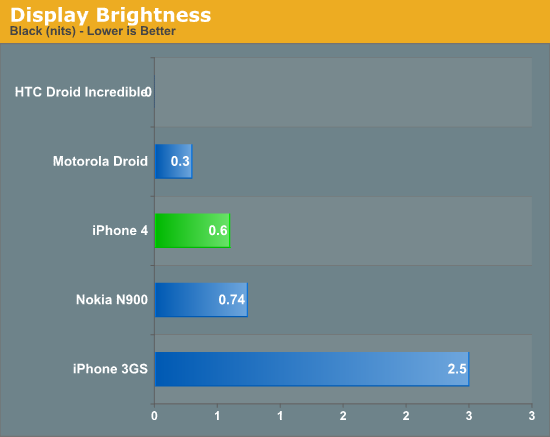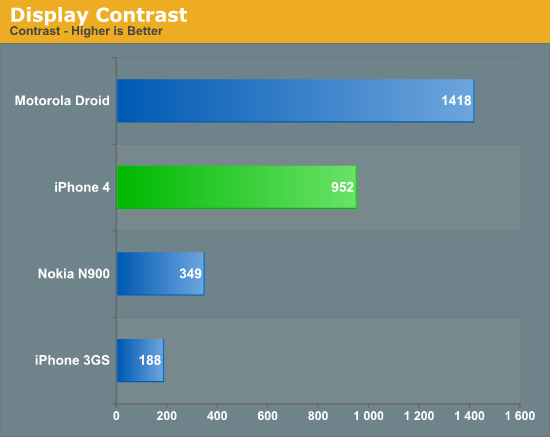Apple's iPhone 4: Thoroughly Reviewed
by Brian Klug & Anand Lal Shimpi on June 30, 2010 4:06 AM EST- Posted in
- Smartphones
- Apple
- iPhone 4
- Gadgets
- Mobile
More Display
It's obvious how Apple settled on 960x640; it's four times the resolution of the previous iPhones. However, instead of decreasing text size, iOS 4 scales appropriately, and the size of everything remains the same. The result is that there are small details everywhere that pop out. Apple's icons on the home screen are the first that really pop out, and new iOS 4 optimized applications will bring that increased detail as developers add higher resolution artwork.
The display panel itself uses a subset of IPS (In Plane Switching) display technology called Fringe Field Switching (FFS). Where IPS switches the crystal polarization in the plane of the display with two opposing electrical substrates composed of semi opaque metals (which decreases transmission and viewing angles), FFS uses considerably less metal by arranging the electrodes in a comb like structure.

See that - it almost looks like a comb. Or an impulse train. Or Dirac comb. So many combs.
The result is that there's considerably less metal in back and in front of the pixel, resulting in much higher transmission of light through the display, and higher brightness for a given backlight level. Using FFS to drive pixel switching is critical here because of the high dot pitch in the iPhone 4's display.
The other interesting difference between iPhone 4's retina display and previous displays is that the digitizer is in optical contact with the display itself. There's no longer an air gap, and as a result, no longer any opportunity for dust to gradually work its way inbetween. Over time, I've noticed a few dust specks creep in on my 3GS, it does happen. The digitizer and display panel are essentially laminated together. The added benefit is that fewer material interfaces results in fewer internal reflections - think the "super" in Super AMOLED but applied to TFT. That's what Apple has done here.
Apple is using Corning's Gorilla glass which touts hugely increased scratch resistance and robustness. Both the front and back of the iPhone 4 are that same type of glass. I've noticed a few superficial scratches (called sleeks) that have appeared on the back, but really the true test will be how the phone looks after 6 months in the pocket. It's interesting that the iPhone capacity markings have disappeared from the back of the phone - no doubt this was done so Apple could make one part and one part only for each color.
The rest of the details are in the specifications. Apple advertises increased brightness of 500 nits and a contrast ratio of 800:1. We measured, and our iPhone 4 exceeded specs at 571 nits and just under 1000:1 contrast ratio.



Note that the HTC EVO 4G is missing as Anand has it, but it's on its way to me. As soon as I get it, I'll measure display brightness, black point, and contrast and update these results. In addition, the HTC Droid Incredible (and thus Nexus One) contrast is effectively infinity by the way we calculate, due to pixels being completely turned off in the black state. In addition, I'm led to believe that the AMOLED's PenTile grid throws off our numbers when measuring brightness. I've run and rerun this test, it keeps coming up that way.
Next to the iPhone 4, the 3GS display really shows its age. It leaks light when displaying black, with an absurdly high black point of nearly 3 nits. Just looking at the lock screen on the iPhone 4 next to the 3GS it's readily apparent how much better blacks are. iPhone 4 easily bests the 3GS but still isn't quite as contrasty as the Incredible or Nexus One AMOLED displays, or the IPS in the Motorola Droid. You do get higher resolution and brightness, however, but nothing is free.
Going from the iPhone 4's display back to the 3GS is pretty painful, but going back to even relatively high dot pitch displays on the desktop is painful as well. Even on the "high resolution" MacBook Pro with 1680x1050 display, displaying an iPhone 4 screenshot at native resolution uses up 91% of the height. If there's one thing I hope the iPhone 4 display does, it's generate demand for 300 PPI level desktop displays - the era of 110 PPI displays being the norm needs to end now.










270 Comments
View All Comments
philosofa - Wednesday, June 30, 2010 - link
This kind of in-depth and insightful review is exactly why I read pretty much every Anandtech article (that and a liberal workplace when it comes to browsing lol). Cheers very much Brian & Anand. Don't feel a huge urge to upgrade from my 3GS, but it does look like a pretty damn fine smartphone!quiksilvr - Wednesday, June 30, 2010 - link
Yeah, but he's holding it wrong :(medi01 - Wednesday, June 30, 2010 - link
But guys, who do you pay a fortune for these phones? If you'd buy iphone or whatever phone with 2 year contract in most of Europe you'd pay just the price of the phone over 2 years (a bit more, in case of iphones it's about 700 Euro)I mean, aren't there cheaper contracts? I could imagine, that you can't buy some models other than from mobile providers, but hey, there are other countries with online shops.
Snotling - Thursday, July 1, 2010 - link
In north America and even more in Canada, there is a lot of territory to cover and lower population density. Cellular networks need to plant antennas where there is theoretically too few users to pay for it.JimmiG - Thursday, July 1, 2010 - link
Sweden is kind of like a smaller version of Canada. Apart from the three major metro regions (Stockholm, Malmo and Gothenburg), the country is very sparsely populated. An average city is maybe 50,000 people. Yet we have extremely affordable plans by comparison.. I mean like less than $10 for a perfectly usable plan (1GB of data or so) and no more than $20 for 5GB or even Unlimited. Paying $100 a moth..geez. I barely pay that in a year.Ratinator - Friday, July 2, 2010 - link
Sorry, I think that is a bad comparison.Sweden is 2/3rd the size of the province of Saskatchewan and 9 times the population of Saskatchewan as well. You can't even compare Sweden to the province of Saskatchewan let alone Canada. You have roughly 13.5 times the population density of that province. Mind you this is probably least densely populated of the provinces (not territories) Maybe not the best example, but lets look at a better one.
You could maybe compare to Ontario (our most populated province) however, you are less than half their size with 80% of their population. When calculated out you still have almost twice the population density of our most populated province.
ABR - Monday, July 5, 2010 - link
It's pretty hard to find countries with similar population density to Canada, ranked 228 out of 239 in the world according to wikipedia. On the other hand, most of the country is inaccessible by road and I seriously doubt you are putting up cell towers in Nunavut. On the other hand Finland has half the population density of the United States and yet has similar cellular and broadband rates to Sweden. We don't know what it is with North America, whether a lack of competition, cartel agreements, or all the companies being weighed down by historical investments, but you guys do lead the world in what you pay for communications.Guspaz - Wednesday, October 12, 2011 - link
According to the CIA world factbook (yes, I use a foreign agency's site for info on my own country), 90% of Canada's population lives within 160km of the US border.If we make an estimated measurement and take the southern border's length at 6416 km, multiply that by 160 and you get an area of about a million square kilometres with a population of, adjusting for the 90%, about 31 million. That would be an actual density in that region of about 31 people per square kilometre.
That puts us in 180th place, right behind the US in 179, which has a density of 32. This is close enough to say that, within our populated region, we've got about the same population density as the US.
ripwell - Saturday, July 3, 2010 - link
Are you comparing data plans to voice and data plans? Telia was blasted when the iPhone first came out with some of the most expensive plans in the world. It's pretty amazing if you're suggesting that you can now get voice and data for just $10 a month.JimmiG - Sunday, July 4, 2010 - link
"It's pretty amazing if you're suggesting that you can now get voice and data for just $10 a month. "You rarely get pre-paid minutes here unless you really want to. You just pay about $6 a month and get billed for your minutes afterwards. In my case, it's about 10¢ per minute, but to phones on the same network, you get unlimited texts, mms's and minutes. Yes, for $6 a month. That includes most of my friends and relatives that's pretty much what I pay for voice and texts.
Then on top of that, you can add your data plan, for example 1GB a month at 6Mb is $9 (add $7.8 for 5GB at 10Mb/s).
-Or, if you really must go crazy, you can get 3,000 minutes for $65. Combined with 5GB/month at 10Mb/s, you're paying roughly $82. That's the absolute maximum. No subsidized phone, but you get over 3x more minutes than the iPhone deal and 2.5x the amount of data. The phones aren't really subsidized at all when you look at the total cost.
"You could maybe compare to Ontario (our most populated province) however, you are less than half their size with 80% of their population. When calculated out you still have almost twice the population density of our most populated province. "
But what about the US? Its population density is 32/km2 vs 20.6/km2 for Sweden. There are definitely states that are comparable in size and population density.